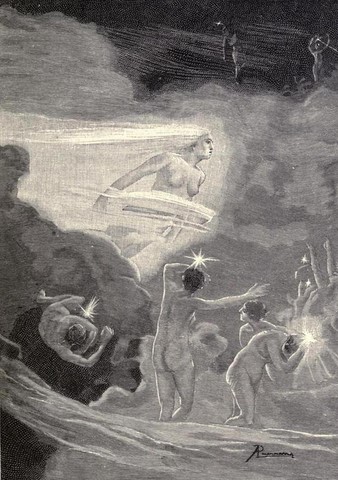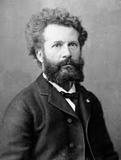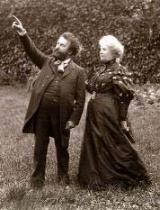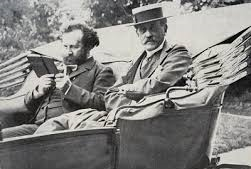The End of the World - A Summer Reading
Camille Flammarion's OMEGA: THE LAST DAYS OF THE WORLD

In 1894, French astronomer and scientific popularizer Camille Flammarion published one of the first science-fiction novels, the ground-breaking "La Fin du Monde," eng.: Omega: The Last Days of the World, where, in the 25th century, a comet threatening the World with destruction brings major political changes, yet Doom, in the end, cannot be staved off... This novel would inspire generations of sci-fi writers, including, as did many of Flammarion's books, both of fiction and non-fiction, H.G. Wells...
(with thanks to the Gutenberg Project)
...Prior to the fatal week, the mortality had increased threefold, and on the 10th fourfold. This rate of increase had been arrested by the confidence produced by the sessions of the Institute, and had even diminished sensibly during Wednesday. Unfortunately, as the threatening star drew near, the panic had resumed its sway. On the following Thursday the normal mortality rate had increased fivefold, and those of weak constitution had succumbed. On Friday, the 13th, the day before the disaster, owing to privations of every kind, the absence of food and sleep, the heat and feverish condition which it induced, the effect of the excitement upon the heart and brain, the mortality at Paris had reached the hitherto unheard of figure of ten thousand! On the eventful night of the 14th, owing to the crowded condition of the cellars, the vitiation of the atmosphere by the carbonic-oxide gas, and suffocation due to the drying up of the lining membrane of the throat, pulmonary congestion, anæsthesia, and arrest of the circulation, the victims were more numerous than those of the battles of former times, the total for that day reaching the enormous sum of more than one hundred thousand. Some of those mortally effected lived until the following day, and a certain number survived longer, but in a hopeless condition. Not until a week had elapsed was the normal death-rate re-established. During this disastrous month 17,500 children were born at Paris, but nearly all died. Medical statistics, subtracting from the general total the normal mean, based upon a death-rate of twenty for every one thousand inhabitants, that is, 492 per day, or 15,252 for the month, which represents the number of those who would have died independently of the comet, ascribed to the latter the difference between these two numbers, namely, 222,633; of these, more than one-half, or more than one hundred thousand, died of fear, by syncope, aneurisms or cerebral congestions... (p.183)
Camille Flammarion (1842-1925) - astronomy, sci-fi and spiritism

Camille Flammarion was born 1842 in Montigny-le-Roi, a town in Franche-Comté. His parents were small farmers, who ran a little haberdashery on the side. When he was age six, his mother made him watch the annular solar eclipse of October 9, 1848 in a water-filled bucket, which he would credit for having awakened his passion for astronomy (Kepler’s mother, too – who was later put on trial as a witch – triggered her son's interest in astronomy when she took him to the hills at about the same age to watch an eclipse of the moon). Camille was bright enough – he could read and write by age 4 and showed an intense curiosity for the nature surrounding him, especially for the abundant fossils which were present in the region – to be easily admitted at age 11 to the seminary at Langres, in the hope that he might become a priest. In 1854, Montigny-le-Roi was hit by a cholera epidemic, people fled to the larger cities and the Flammarions’ lost their business and were forced to sell off whatever properties they had. The family left for Paris, destitute, leaving Camille behind in the custody of the local priest. Two years later, no longer able to pay for his upkeep, his parents sent for him to join them in Paris and to help sustain the family by taking on manual labor. He was apprenticed to an engraver.
The 14year-old took to engraving with pleasure but would not give up on his studies, however, and undertook to teach himself, skipping meals to save money to buy books, taking evening courses after long workdays in the hope of being received at the baccalauréat exam, which would have opened him access to higher learning. As a result, he fell seriously ill of overwork at age 16. He had the good luck of being treated by a young Dr Fournier who was intrigued enough by the books he found in his sick-room, and properly astonished when the lad showed him a 500 page-manuscript he had written, under the title : « Cosmogonie Universelle. »
Dr Fournier, who had a good network of acquaintances, was able to bring this remarkable case all the way to the attention of Urbain Le Verrier, the director of the Paris Observatory and famous discoverer of the planet Neptune. After a prompt recovery, Camille was received for a short interview by Le Verrier, who hired him as an apprentice astronomer with a monthly salary of 50 Francs. Alas, he was put to work at the Bureau of Calculations, doing tedious mathematical work, and didn’t get to look through the telescopes, as he had hoped for. After hours, and while finishing up his formal studies, he took on work as an assistant to astronomer Jean Chacornac in direct sky observations. He would much later write in his memoirs :
I had the great luck [during my career] to see the birth of the spectral analysis of the heavenly bodies, the photographing of the sun, of planets, comets, stars and nebulae, and of all the methods which, in this past half-century, have substitued the lively physical astronomy to the old, lethargic mathematical astronomy. »
Age 20, in 1862, hoping to extricate himself from a life of calculations, he published his first book at the bookstore of MM. Mallet-Bachelier in Paris : « La Pluralité des Mondes Habités, » - The Plurality of Inhabited Worlds. The book turned out to be a sensation, in France and on both sides of the Atlantic. Victor Hugo wrote him a fan letter, emperor Napoleon III asked to meet him (which, being a staunch republican, he refused). He had become interested in Buddhism and spiritism and had joined the lively circles around Allan Kardec in Paris, a former disciple of the Swiss pedagogue Pestalozzi and a pioneer of popular education, who had recently published the first of his founding books of spiritism. Flammarion corresponded with the British National Association of Spiritualists and the American Branch for Psychical Research, both of which helped to spread his fame. All this turned out to be too much for his boss, Urbain Le Verrier, who fired him.
Le Verrier was not able to cut him off from legitimate scientific activities, though, for he had made powerful friends by then, and he quickly found another employment at the Bureau of Longitudes, calculating the annual ephemeris of the Moon. He went on writing articles and books and giving conferences whipping up popular enthusiasm for astronomy, as well as for other phenomena of the natural sciences, such as lightning and earthquakes, all his scientific work being carefully researched, in the lab as well as in the field, including several trips in balloons to study atmospheric phenomena. He stuck to spiritism and spoke Allan Kardec's funeral oration at his burial in 1867. He forged ties with the makers of astronomical and optical instruments, such as Bardou, whose business experienced then a relative boom thanks to the new popular interest in the sciences, to which he himself was mightily contributing, and he became an expert in astronomical instruments. The dechrisitanized, largely deist and politically empowered bourgeoisie which had been born of the Enlightenment and the French Revolution took enthusiastically to the individualistic investigation of the wonders of the universe, and was optimistic that science would be able to prove both the existence of a Supreme Being or of superior beings, and the immortality of the soul.
With his success growing, Flammarion didn't hesitate to take on his former boss, Urbain Le Verrier, and ganged up with other astronomers who had come to suffer from his dictatorship at the Paris Observatory, in an attempt to dislodge him from his position. No fool, the discoverer of Neptune promptly re-hired Flammarion to the Observatory, and put him in charge of creating: Binary Stars: a Catalogue of Moving Multiple Stars.
In 1874, Flammarion got married to Sylvie Pétiaux, a staunch pacisfist and feminist, and took her on honeymoon in a balloon. Their marriage would last 45 years.
1879 was the year of his greatest success, when he published "L’Astronomie Populaire," Popular Astronomy, which brought him immense fame and was translated in some thirty languages. The publisher was his younger brother Ernest Flammarion, for whom Camille had found a job a decade earlier with one of his publishers, the bookstore Didier in Paris, and who had decided to take off as a publisher on his own. "L'Astronomie Populaire" propelled Ernest Flammarion's publishing house to one of the leading publishing houses in France, a family empire which was to be run by four generations of Flammarions, and which is still a thriving publishing group. The book promoted the use of a small model telescope, "the school telescope" created by Bardou and Camille himself. Flammarion created an accompanying magazine of popular astronomy "L'Astronomie," and a series of guides which would become the bible of amateur astronomers for several generations: « l’Annuaire Astronomique Flammarion » and the « Grand Atlas Céleste », all published by his brother Ernest.
In his conferences, Flammarion promoted the use of astronomical photographies and dias - to which he had been introduced by his father who, after moving to Paris, had become employed by the famous pioneer of photography, Nadar. Obviously, the former small-time farmer and haberdasher had had "something" in him, too, and, given the opportunity, had made good on it.
One enthusiastic reader of "L’Astronomie Populaire », a rich landowner from Bordeaux, made Flammarion a gift of a vast property and a parc in Juvisy-sur-Orge, near Paris, on condition that he transform it into an observatory. This was done, and it became one of the primary private astronomical observatories and scientific research centers in Europe. It was inaugurated in 1887 and Camille Flammarion founded the Société Astronomique de France in the same year. It was equipped with a highly advanced 240mm telescope with a 3750mm focal, magnifying 600 times. The observatory studied the physical nature of the planets of the solar system and developed the use of astronomical photography, as well as studying meteorology and radio culture (i.e. the effect of light of different colors on the growth of plants).
True to Flammarion's life-long commitment to the Plurality of Inhabited Worlds, Juvisy focused intensely on the study of Mars, on the examination of its then promising canals, seasons and polar caps. Percival Lowell came from Flagstaff, Arizona, and Schiaparelli came from Italy to observe Mars at Juvisy. Flammarion never made significant astronomical discoveries of his own, but his action helped to greatly improve astronomical and scientific knowledge, of the solar system (sun spots, spots on Venus, Saturn's rings, Jupiter, etc...) as well as of the deep sky (binary stars, star clusters, nebulae, galaxies...) His observatory would discover two comets, in 1893 and in 1911. It is after the discovery of the first that he wrote his novel of science-fiction "La Fin du Monde" - Omega: The Last Days of the World. He was a true pioneer of the genre, with an innumerable posterity on both sides of the Atlantic.
By the beginning of the 20th century, radical shifts of paradigms were occurring in the science of the Universe as well as in the knowledge of the human "soul." The basically optimistic world-view inherited from the Enlightenment and the belief in the intrinsic goodness of scientific progress went into a crisis and would be dealt a death blow by World War One. Sylvie, who had founded in 1899, in face of mounting international tensions, a feminist movement called « Peace and Disarmament through women,» died in 1919 in the outbreak of the Spanish Flu which followed the war. Flammarion died suddenly on June 3, 1925, age 83, of a heart attack. He had remarried in 1920 with his assistant, one of the rare women in France at the time to have a baccalauréat, Gabrielle Renaudot, who would survive him 37 years, become a distinguished astronomer herself and carry on his legacy.



